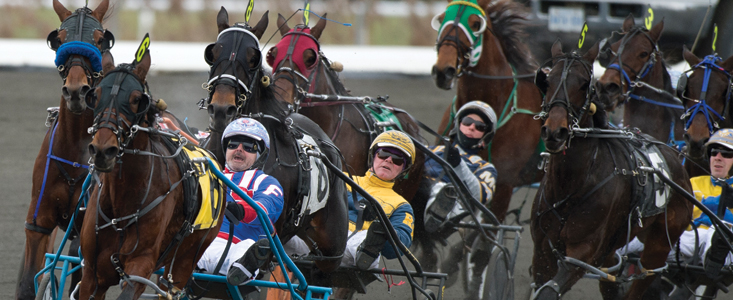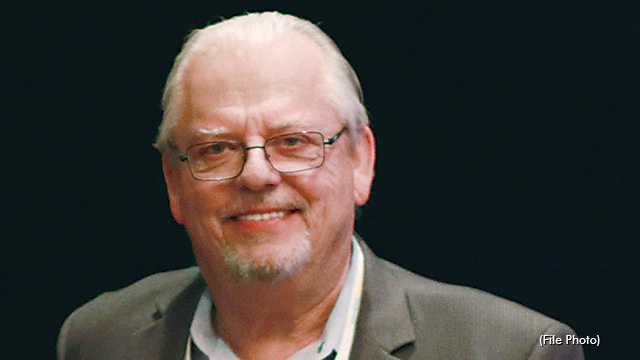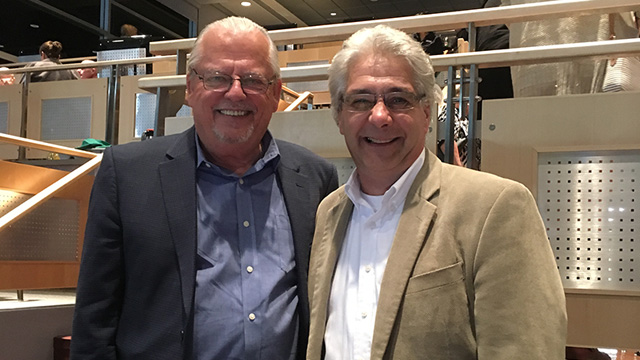In July, Rob Cook was named the Executive Director of Ontario Racing. TROT Magazine sat down with Cook for a one-on-one interview, to learn about his background, the role of Ontario Racing, and his view of the future of the sport in Ontario. By Darryl Kaplan

TROT: Can you tell us a little about your experience and your new role in the horse racing industry?
Rob Cook: Clearly my background is not in horse racing. I don’t profess to be an expert in horse racing. What I do have is considerable experience and knowledge in not-for-profit associations, government advocacy, marketing – the kinds of skills and experience you need to run a strong industry association. I’ve worked in two major industry associations. I’ve had the senior staff position in both those organizations – CEO and President – so that’s my background. There are lots of people that have huge experiences in this industry. I need to rely on those people as I build my knowledge of horse racing.
TROT: What are the key things you’ve learned in the past few months?
Cook: What intrigued me about this industry are the complex policy issues. Not that they’re that much more complex than other industries, but these issues are unique in the horse racing space. Clearly the first observation I made is that there is scar tissue and a focus on what has happened (in the past). It’s a huge shift. What has happened is a challenge, in changing the focus to look forwards instead of backwards. I run into that every day for sure.
TROT: What should the industry know about Ontario Racing?
Cook: Ontario Racing was formed on the notion that the industry needs a strong industry association to speak to government. Government has supported that. OR has been in operation for the past eight months. We’ve recently been using the OHRIA (Ontario Horse Racing Industry Association) Board in an advisory capacity and the decision was made for them, on an interim basis, to officially be the Ontario Racing Board. We recognize that’s an interim step. OHRIA isn’t necessarily 100% representative of the industry today, so we also have a governance group that has been charged with developing a new governance structure for the Board and ensuring that there is complete representation of the industry. The expectation is that there will be a new structure by the end of 2016/beginning of 2017 - at the latest.

TROT: How do you address a general feeling from some groups who may feel that this group doesn’t represent them. How do you bring them in?
Cook: If that was easy, there are many other things I could or would do. That’s not an easy challenge. There’s lots of organization in this space and there are many individual interests. We have challenges related to horsemen’s representation on the standardbred side. All we can do is make sure that OR has a structure that provides a conduit for everyone in the industry and hopefully OR will represent the views of everyone. But it’s always going to be hard – we’ll have to operate based on consensus.
TROT: What about some more divisive issues like what tracks will race. Will OR make recommendations on those issues?
Cook: The structure that is envisioned is for post 2021, and possibly earlier if it’s the wish of the industry - the concept when it’s in place would be to have one racing alliance that includes all tracks. The government will funnel its funding support through one transfer payment to that alliance. That alliance will make decisions. There will be linkages between public money and what the return is - employment return, wagering return and more sustainability. That puts decisions in the hands of the industry and it starts to put a more sustainable business case to how you make investment.
The alliance would develop a program on what racing would look like, where it happens, purse levels and dates. That would be approved by the Board of Directors of the alliance. There are tough decisions to make there. That report goes to the Ontario Racing Board of Directors to provide an approval process. So the presumption is if OR is concerned with how money is allocated, there would be some mechanism for dealing with that. If OR believes that proposal is in the best interests of the industry, it would approve it and it would go on to OLG, which would have an approval process, and ultimately to AGCO which has the regulatory oversight. There’s lot of stop points to have checks and balances.
TROT: There was a recent announcement of a new horsemen’s alliance group. Are you concerned at all that there will be other groups that will go directly to government and give them different messages than the one being given by OR?
Cook: That’s the prerogative of other groups to do that. If they feel they can’t get their message through OR. It will be up to government to whether they listen to other groups or not. Am I concerned about it? If there’s not a consistent message from the industry, that’s bad for the industry.
Where there are other groups and other interests, we want to align together as best we can to present a common message. OR is not on an empire building exercise to try to consolidate the industry under our wing. We need to make sure we’re working on a common message because that’s the only way we give the industry the strength it needs to push back on government.
TROT: How about concerns that OR may be too close to government? If issues come up where the industry feels they really need to take a stand with government, is OR independent enough to do that?
Cook: I can understand where people may have that view looking outside-in because we have spent a lot of time working with government to try to get a long term funding arrangement, so we can consult with the industry. So in some ways to our detriment, we’ve spent a lot of time looking at government and not at the industry but I expect that page to turn once we’ve started moving forward, looking at what we really need to do. Clearly, OR’s vision is that we’re the representative of the industry [in Ontario] and if that means taking hard positions with government in the interests of the industry, that will happen. That needs to be tempered that we take responsible, realistic approaches. We’ve already talked to the opposition. People may see government as too close, but I don’t think that’s the case.
TROT: When it comes to the plan being proposed to the industry, is the plan set, and the consultation is about tweaking the plan, or is the slate open for something different if you heard opposition?
Cook: We want to hear from the industry - every point of view. If people don’t think this is the right plan, we want to hear that. If this is not the plan, we want to hear other options. It’s not a done deal. It needs to be negotiated. There are lots of question marks and even in the early part of consultation there are areas that are already on the table.
TROT: What is Woodbine Entertainment Group’s role in this proposal, and what should it be going forward?
Cook: I know there are lots of opinions about WEG but I think when you look at the industry it’s pretty hard to imagine the industry operating without the facilities that WEG operates. WEG has provided a key management role in the Standardbred Alliance. They are the big player in the game and that sometimes makes people uncomfortable. What we’ve tried to do is develop something where we can leverage the expertise, knowledge and resources of WEG for the betterment of everybody and have the checks and balances to make sure that’s always done for the best interests of everyone. WEG does not have the majority of directors so there are other people that will have decision making in the alliance. There are counterbalances and checks in place.

Rob Cook with Standardbred Canada President & CEO Dan Gall
TROT: What’s your feeling about government and how they see horse racing in Ontario, from the very top down?
Cook: People in government recognize the horse racing file as a very difficult file. That’s probably based on the history of it, the Slots at Racetracks program, and the fallout from it. What we have seen is a genuine interest and commitment at the political level of the government to be helpful. People can blame the government for being where we are today but I think there is a legitimate political commitment to support the industry. It also exists on the opposition side - probably both parties.
TROT: The plan that the industry is currently being consulted on details a government funding extension in Ontario for 17 years beyond 2021, but the structure is divided into separate parts?
Cook: It’s really structured as seven years guaranteed and the option for two, five-year renewable terms, and the five-year terms are based on performance indicators. Has the money that’s been invested for seven years got us further ahead for a sustainable industry? Seven years is committed and they would look at measures and indicators and see if there is growth, is wagering coming up, is the industry doing better, and if so, they would renew for another five. It’s metric performance-based thinking.
TROT: Where does OMAFRA (Ontario Ministry of Agriculture, Food and Rural Affairs) fit in?
Cook: They have an interest in horse racing. The Minister is interested. As a Ministry, they do provide funding for the enhanced Horse Improvement Program (HIP). It wasn’t until fairly recently that the transfer payment agreements with OMAFRA, to support the enhanced HIP program, were extended from 2019 to 2021. We are trying to get confirmation of enhanced HIP from 2021 forward. People will clearly recognize that the amount of money is $93.4 million. What is absent from that is the current seven odd million for enhanced HIP. With the enhanced HIP it’s $100 million, not 93. We don’t know where the ministry is on enhanced HIP. Our hope is that we will be able to receive some kind of commitment through negotiation that OMAFRA is still engaged in supplying those dollars through a different pool of money, to support those activities. They have an interest in the rural and economic development impact of the industry.
To be honest the very first discussion we had around the long term funding arrangement, it was the first question, what about enhanced HIP - 2021 and beyond, because it’s critical to breeders. We didn’t have an answer. We still don’t have an answer. Everybody including government is crystal clear that breeding and investment cycles are four to five years and people need to make decisions based on that.
TROT: What’s been your impression of the everyday horseperson?
Cook: It’s easy to say – It’s an industry full of hardworking people and people that have a genuine interest in success of their own business and of the industry. I have been in the backstretch, in paddocks, at as many racetracks as possible, I’ve visited breeders. I’ve tried to reach out. I’ve said at the start that I don’t know a lot about horse racing but that’s not the long term objective. I need to know as much as I can as quick as I can. It’s a good industry full of good people. Lots of people have opinions and some of them aren’t always positive, but that’s ok. You need to hear those just as much as you need to hear others.
TROT: What should OLG integration mean to the industry? Are new gaming products a part of it?
Cook: Our view is that at some point, whether it be betting at corner stores, historical horse racing, or other products - which are things being talked about right now again - those are extra revenue sources that need to come to bear for horse racing to be successful in the long run. There is dialogue within OR on what types of products are needed, and discussion with OLG about how we can move toward some of these products.
A key point is that this funding agreement, and the money we’re talking about, is not enough to keep the industry sustained. We are going to focus back on things like product development with OLG. Clearly we have to find other ways to grow wagering and other products that can bring sustainability to the industry. The industry needs to be more self sustaining.
TROT: Is there any other message that you want the industry to know about OR?
Cook: My goal is that the industry sees Ontario Racing as their champion. That doesn’t mean everybody is always going to be in the same place and on the same wavelength, but generally the success of representing the industry means that OR has to have that role, and people have to see that role. If we don’t do it, that’s a problem, but if people don’t see OR as valuable, that’s a problem as well. There’s work to do there. I know that, as do my staff and the Board at OR. Hopefully at the end of these consultations we can move from a point of frustration to a sense of what they like and what they don’t like. Clearly Ontario Racing has said to government that we need the consultation results. This next step is negotiating an agreement.


